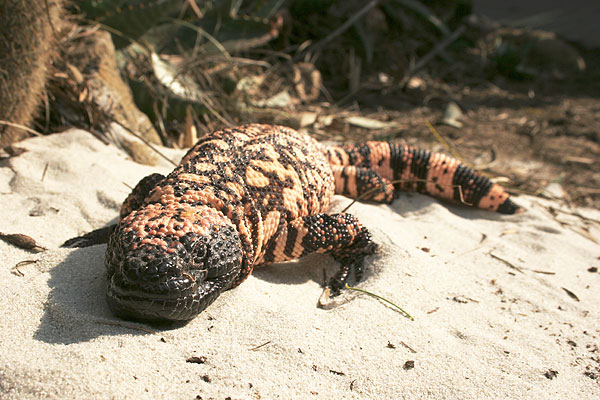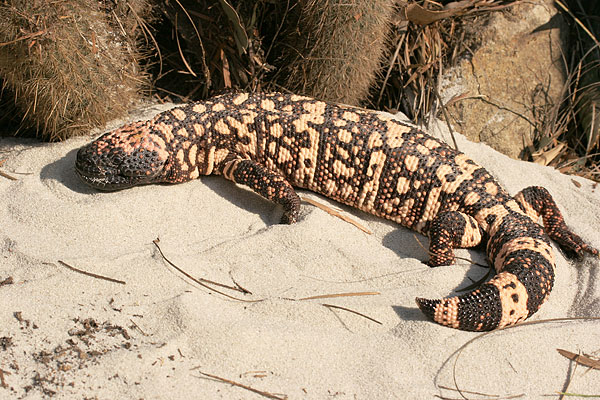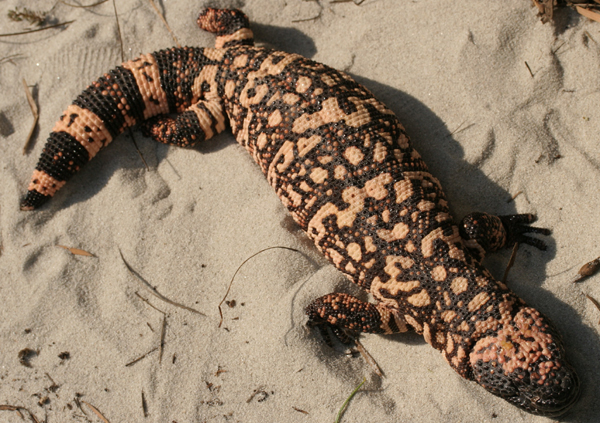Southern Reticulated Gila Monster
Heloderma suspectum suspectum
The Gila monster is the largest of the lizards found in the United States. It received its name from the Gila River Basin where it was first found. Unique in appearance and habits, it is well adapted to its preferred habitats of desert lowlands and foothills. It is venomous with toxicity similar to that of the diamondback rattlesnake, but because of limited ability to inject its venom, it is not as dangerous and its bite is not considered lethal. Populations are declining and the species is protected in all areas of its distribution.

Gila monster at Los Angeles County's Natural History Museum Credit: © A.Reitsma. Aquarium of the Pacific

Credit: © A.Reitsma. Aquarium of the Pacific

Credit: © A.Reitsma. Aquarium of the Pacific
SPECIES IN DETAIL
Southern Reticulated Gila Monster
Heloderma suspectum suspectum
CONSERVATION STATUS: Threatened - Protected
CLIMATE CHANGE: Not Applicable
At the Aquarium
These reptiles are no longer on exhibit. Information about Gila monsters is included in the Ocean Learning Center for use as a reference.
Geographic Distribution
Sonoran, Mojave, and Chihuahuan deserts including southwest Utah, southwest New Mexico, southern Nevada, the southeastern tip of California, and northern Mexico.
Habitat
Gila monsters are most commonly found in desert lowlands and rocky mountain foothills, but on occasion may be found at altitudes of up to 1,500 m (5,000 ft). They prefer areas that are moist enough to support desert scrub shrubs, palos verde trees, and some cactus species, but will also frequent more arid sandy areas. They generally avoids cleared or open areas such as agricultural lands.
Physical Characteristics
This species is the largest of the lizards found in the United States. Contrary to the usual sleek forms of most lizards, the Gila monster is a stoutly built, plump animal with a thick tail, short but sturdy legs, and wide feet that end in five toes tipped with short, sharp, curved claws. Its head is large and roughly oval in shape and ends in a blunt nose.
The upper part of the body is covered with sturdy, bead-like scales that fit side by side rather than being overlapped like the scales of most lizards. The scales toward the belly transition to more plate-like structures. The basic background color is black with varied patterns of pink to orange to yellow. The nose, jaws, and eyes are dark in color.
Size
Full- grown adults range in length from 46 to 61 cm (18 to 24 in) and may weigh up to 2.3 kg (5 lb) or more.
Diet
These animals are carnivores that feed on a variety of animals. Some of their favorite food items are eggs of and newly hatched ground nesting birds, snakes, lizards, and tortoises. They will also eat the very young of rodents and rabbits, some insects, and carrion.
Young Gila monsters are able to consume up to 50% of their body weight at one feeding and adults can eat up to 35% body weight at one time. They may be able to survive nicely on three to four full feedings a year. Resting metabolism rates are very low during extended periods of inactivity and large fat deposits stored in the tail and the bodies provide nourishment for extended periods.
Reproduction
Maturity is reached in 1-3 years depending on temperatures and availability of food supply. As the April to June breeding season approaches, males become more active and territorial. Dominance is exhibited by body lifting and head bobbing displays. Males may fight, sometimes for hours. Courting involves the male flicking his tongue, rubbing the female’s neck, and touching her with his snout. Mating may take from 15 minutes to over two hours.
In mid to late summer, the female prepares a nest by digging a hole into which she deposits 2 to 13 leathery eggs. She does not incubate the eggs. They over-winter in the nest and hatch during the following spring. New hatchlings are about 12.7 cm (5 in) in length and look like miniature adults. There is no parental care and the independent hatchlings scatter within a few days.
Behavior
Gila monsters are solitary and secretive animals and there is probably still much to be learned about them. They spend most of their time underground or hidden in rock cavities, abandoned animal burrows, or holes that they dig. They are diurnal but time out of their burrows is mostly in the morning and the evening, apparently to avoid high temperatures from the mid-day sun. They are seen above ground more often in the spring months, the time when their preferred food supplies are most readily available. They are also active then looking for breeding mates.
They are very sensitive to internal body temperatures and balance time between their cool dens and the warmer outside air to maintain acceptable levels. Moisture levels are also important to their health. They do not drink water, but receive necessary moisture from their food and prefer some humidity in the air of their dens.
These animals are generally non-aggressive, sluggish, and move slowly, but when threatened can move with surprising agility. They have a venomous bite. Their venom, essentially identical to that of a diamond back rattlesnake, is produced and stored in glands in the lower jaw. Unlike the rattlesnake that delivers its venom through fangs under pressure, the Gila monster delivers its venom through grooves in the lower teeth. The bite of a Gila monster is quick and very strong and detaching an annoyed animal is next to impossible. The wound receives small amounts of venom. Reports vary, but the consensus seems to be that Gila monster bites are not deadly, but are extremely painful.
Adaptation
Gila monsters are well adapted to what can be a very harsh desert environment. The heavy, bead-like scales on the upper part of the body protect them from the rocks, bushes, cactus and similar annoyances of their surroundings. The mix of bright colors and color patterns provide good camouflage and may even warn some would-be predators of a potentially dangerous prey.
Also aiding in their survival is their ability to eat very large meals and store energy in the form of fat, and their ability to regulate resting metabolic rates and body temperatures to minimize food requirements. Acute senses of sight, hearing, smell and taste assist them not only in finding food, but help them to avoid some dangers. Their predominantly underground existence, reported to be up to 98 percent of their lifetime, protects them from would-be predators.
Longevity
Gila monsters may have a life span of 20 to 30 years. Specimens living in protected environments probably live longer than those in the wild.
Conservation
There are no federal regulations protecting Gila monsters; however, Mexico and all states where they occur naturally (Arizona, New Mexico, Nevada, Utah, and California) protect these animals, requiring permits for their possession. California lists the banded Gila monster subspecies, H. suspectum cinctum, which is native to California, as a species of special concern. Private individuals are not given permits to keep the lizard. The are illegally captured for pets.
Probably the greatest danger to these animals is human encroachment and the loss of habitat due to the clearing of land for agricultural and residential purposes and the construction of roads.
The Gila monster is designated as Near Threatened in the IUCN Red List (2007). It is also listed in CITES – Appendix II, which regulates trade of certain species and animal products.
Special Notes
In 2005 the U.S. Food and Drug Administration gave final approval for the use of a new drug called Byetta™ for treatment of individuals with Type 2 diabetes. The active ingredient of the medication, called exendin-4, is a hormone fraction of Gila monster venom and acts on the digestive system to help regulate blood sugar levels. Fortunately for the Gila monsters researchers have been able to synthesize the material that occurs in a natural state in the animals.
Native Americans had mixed feelings about Gila monsters. Some believed that the animal could cause sickness. The Apache felt that the lizard could cause the death of a person it breathed on and yet other nations felt that its hide had curative powers.
SPECIES IN DETAIL | Print full entry
Southern Reticulated Gila Monster
Heloderma suspectum suspectum
CONSERVATION STATUS: Threatened - Protected
CLIMATE CHANGE: Not Applicable
These reptiles are no longer on exhibit. Information about Gila monsters is included in the Ocean Learning Center for use as a reference.
Sonoran, Mojave, and Chihuahuan deserts including southwest Utah, southwest New Mexico, southern Nevada, the southeastern tip of California, and northern Mexico.
Gila monsters are most commonly found in desert lowlands and rocky mountain foothills, but on occasion may be found at altitudes of up to 1,500 m (5,000 ft). They prefer areas that are moist enough to support desert scrub shrubs, palos verde trees, and some cactus species, but will also frequent more arid sandy areas. They generally avoids cleared or open areas such as agricultural lands.
This species is the largest of the lizards found in the United States. Contrary to the usual sleek forms of most lizards, the Gila monster is a stoutly built, plump animal with a thick tail, short but sturdy legs, and wide feet that end in five toes tipped with short, sharp, curved claws. Its head is large and roughly oval in shape and ends in a blunt nose.
The upper part of the body is covered with sturdy, bead-like scales that fit side by side rather than being overlapped like the scales of most lizards. The scales toward the belly transition to more plate-like structures. The basic background color is black with varied patterns of pink to orange to yellow. The nose, jaws, and eyes are dark in color.
Full- grown adults range in length from 46 to 61 cm (18 to 24 in) and may weigh up to 2.3 kg (5 lb) or more.
These animals are carnivores that feed on a variety of animals. Some of their favorite food items are eggs of and newly hatched ground nesting birds, snakes, lizards, and tortoises. They will also eat the very young of rodents and rabbits, some insects, and carrion.
Young Gila monsters are able to consume up to 50% of their body weight at one feeding and adults can eat up to 35% body weight at one time. They may be able to survive nicely on three to four full feedings a year. Resting metabolism rates are very low during extended periods of inactivity and large fat deposits stored in the tail and the bodies provide nourishment for extended periods.
Maturity is reached in 1-3 years depending on temperatures and availability of food supply. As the April to June breeding season approaches, males become more active and territorial. Dominance is exhibited by body lifting and head bobbing displays. Males may fight, sometimes for hours. Courting involves the male flicking his tongue, rubbing the female’s neck, and touching her with his snout. Mating may take from 15 minutes to over two hours.
In mid to late summer, the female prepares a nest by digging a hole into which she deposits 2 to 13 leathery eggs. She does not incubate the eggs. They over-winter in the nest and hatch during the following spring. New hatchlings are about 12.7 cm (5 in) in length and look like miniature adults. There is no parental care and the independent hatchlings scatter within a few days.
Gila monsters are solitary and secretive animals and there is probably still much to be learned about them. They spend most of their time underground or hidden in rock cavities, abandoned animal burrows, or holes that they dig. They are diurnal but time out of their burrows is mostly in the morning and the evening, apparently to avoid high temperatures from the mid-day sun. They are seen above ground more often in the spring months, the time when their preferred food supplies are most readily available. They are also active then looking for breeding mates.
They are very sensitive to internal body temperatures and balance time between their cool dens and the warmer outside air to maintain acceptable levels. Moisture levels are also important to their health. They do not drink water, but receive necessary moisture from their food and prefer some humidity in the air of their dens.
These animals are generally non-aggressive, sluggish, and move slowly, but when threatened can move with surprising agility. They have a venomous bite. Their venom, essentially identical to that of a diamond back rattlesnake, is produced and stored in glands in the lower jaw. Unlike the rattlesnake that delivers its venom through fangs under pressure, the Gila monster delivers its venom through grooves in the lower teeth. The bite of a Gila monster is quick and very strong and detaching an annoyed animal is next to impossible. The wound receives small amounts of venom. Reports vary, but the consensus seems to be that Gila monster bites are not deadly, but are extremely painful.
Gila monsters are well adapted to what can be a very harsh desert environment. The heavy, bead-like scales on the upper part of the body protect them from the rocks, bushes, cactus and similar annoyances of their surroundings. The mix of bright colors and color patterns provide good camouflage and may even warn some would-be predators of a potentially dangerous prey.
Also aiding in their survival is their ability to eat very large meals and store energy in the form of fat, and their ability to regulate resting metabolic rates and body temperatures to minimize food requirements. Acute senses of sight, hearing, smell and taste assist them not only in finding food, but help them to avoid some dangers. Their predominantly underground existence, reported to be up to 98 percent of their lifetime, protects them from would-be predators.
Gila monsters may have a life span of 20 to 30 years. Specimens living in protected environments probably live longer than those in the wild.
There are no federal regulations protecting Gila monsters; however, Mexico and all states where they occur naturally (Arizona, New Mexico, Nevada, Utah, and California) protect these animals, requiring permits for their possession. California lists the banded Gila monster subspecies, H. suspectum cinctum, which is native to California, as a species of special concern. Private individuals are not given permits to keep the lizard. The are illegally captured for pets.
Probably the greatest danger to these animals is human encroachment and the loss of habitat due to the clearing of land for agricultural and residential purposes and the construction of roads.
The Gila monster is designated as Near Threatened in the IUCN Red List (2007). It is also listed in CITES – Appendix II, which regulates trade of certain species and animal products.
In 2005 the U.S. Food and Drug Administration gave final approval for the use of a new drug called Byetta™ for treatment of individuals with Type 2 diabetes. The active ingredient of the medication, called exendin-4, is a hormone fraction of Gila monster venom and acts on the digestive system to help regulate blood sugar levels. Fortunately for the Gila monsters researchers have been able to synthesize the material that occurs in a natural state in the animals.
Native Americans had mixed feelings about Gila monsters. Some believed that the animal could cause sickness. The Apache felt that the lizard could cause the death of a person it breathed on and yet other nations felt that its hide had curative powers.

